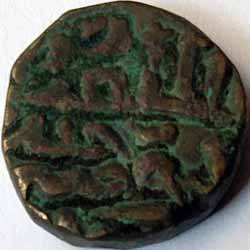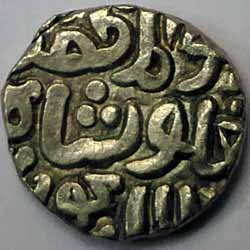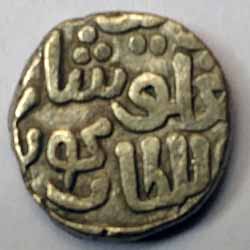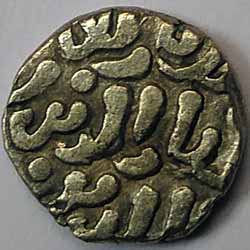Old Indian Muslim or Sultan Coins for Sale
With the advent of Muslims in India, the Indian coinage took on an entirely new form. The representation of figures is avoided in Islam; Thus, Indian coins, like other coins of the Islamic world, had inscriptions on both sides in Arabic or Persian script, with some notable exceptions. In Islam, the inscription of the ruler's name on the coins was invested with special significance. This privilege implied a definite assumption of his legal authority by reciting his name in the khutba (public prayer). This prerogative of Muslim rulers led to the issue of coins on every occasion when they conquered a country or a kingdom or a fort or a city, and bearing their names and the date of the Hijri era. , and the place where the coins were issued. The Crusades of the early Caliphs of Syria in the eighth century AD introduced the Kalima or Profession of Faith – La ila-il-Illah Muhammad-ur-Rasul Allah (There is no god but Allah, Muhammad is the Prophet of Allah) . Later it formed part of the Muslim coins. Here in India too, the Kalima was used on coins, but not with much interest.
The earliest Muslim kingdom in India was established in 712 AD by Imad-ud-Ibn Qasim in Indus. His governors issued some small silver coins in the style of the Caliphs' coins. Such coins are frequently found in Indus and Rajasthan. At the same time, another Muslim dynasty of the Fatimid sect established itself in the Muslim region. Their coins are also small. Both are so similar in their fabric and execution that one can easily be mistaken for the other. But the latter may be distinguished by their fine quality of silver. Two or three rulers are known to have ruled for a period of about half a century (950 – 1000 AD). Mahmud of Ghazni exterminated them in 1001 AD.
Coins of Indus and Multan did not exert any influence on Indian coinage of the day. It was only when the gates of the northwest were opened to Muslim invaders by the invasions of Mahmud Ghazni between 1001 and 1021AD that coins began to undergo a change. In 1007AD, during his travels, Mahmud issued some gold coins weighing 160 grains, bearing the Kalima and the name Al-Qadir Billah Amir-ud-Momanin (Kahalifa-al-Qadir Billah, Amir of the Faithful). A long inscription on the reverse declares, "Dinara (gold coin) struck for cities subdued during the Holy War (Jehad) against India in 397AH," indicating that Mahmud received an investiture from Abbasid Caliph al-Qadir. As the Sultan of Billah, inspired by his religious zeal, he waged a holy war against India. Most likely, these pieces were published to commemorate his victory in some fierce battle or other. But more important are the silver dirhams he issued 20 years later from Lahore in the years 418 – 419 AH (1028AD), after he annexed the province of Punjab to his kingdom (215) and named it Mahmudpur. They write in Kufic script Amin-un-Daula wa Amin-ul-Millat Bismillah al-Tirham Jarb b Mahmudpur Jard Sanh 418 or 419 following the calabash in front. On the reverse, in the Sarda script, there is a Sanskrit translation of the Kalima—Avyaktamegam Muhammad Avatar—followed by the narrator Mahmud. Surrounding it is a translation of the rest of the Kufic legend, which can be distinguished in two forms: (i) Ayin Thangam Hata Mahmudpur Samvati 418; (II) Ayam Dangam Mahmudpur Qadita Tajikier Samvati 418 or 419. The second legend is an improvement on the first rendering and means, "This danga (coin) was struck at Mahmudpur in the Arab year 418 or 419." The presentation of the Kalima in Sanskrit shows remarkable freedom. The Muslim concept of Allah is translated as Avyakta (Invisible), which shows a true understanding of Muslim and Hindu philosophical concepts. By then Mahmud's religious passion for Jehad (crusade) seems to have waned and as a ruler, he sought to understand the sentiments of his conquered subjects.
When the Ghor chieftains expelled the later princes of the Mahmud family from Ghazni, they made Lahore their capital in 1051AD; there they struck small billon coins with bulls of the 'bull-horseman' type on the obverse and a Kufic legend on the reverse with their names and title. The Kalai side retained the name Samanthadeva in the city. Coins issued by the Ghaznavid rulers of Lahore were those of Farokhzad (1052 – 1059AD) Ibrahim (1059 – 1099AD) Bahram Shah (1118 – 1152AD) and Khusru Malik (1160 – 1187AD). The latter was deposed by Muhammad Bin Zam, popularly known as Muhammad Khori. Muhammad bin Sam established the first Muslim dynasty in India after the final defeat of Prithviraja and his allies in the second battle of Thaneswara or Tarain in 1192AD.
Muhammad Bin Sam minted gold coins in imitation of the coins in the country, with a seated Lakshmi on the obverse, and inscribed his name in Nagari script as Shri Muhammad Bin Sam. His general, Muhammad bin Bakhtiar Khilji, issued gold coins in his master's name to commemorate his own conquest of Gaur (Bengal). These coins show a Turkish horseman carrying a tantra and the obverse bears the Nagari words Kaur-Vijaya. The reverse is a long Arabic legend of al-Sultan al-Mu'azzam Muiz-ud-dunid-wa al-Din Abu-Muzaffar Muhammad bin Sam. Muhammad Bin Sam minted silver coins throughout his Indian dominions; but the "bull-horseman type" billion coins are well known, with the Nagari legend Sri Mahamad Sam on the bull side and Sri Hamira on the horseman side. He also issued a few billion coins in which only one of the two devices of the bull-horseman type was used. Some coins have a horseman and some have a bull on one side and Arabic inscription on the other. He also issued some copper coins. After Muhammad bin Sam, some bullion and copper coins were issued by his elder brother's son, Mahmud, and Tajuddin Yildis, who assumed the sovereignty at Ghazni. These coins bearing his name are believed to have been issued by local governors. On their coins a bull or a horseman is seen on one side.
Jaunpur Sultans Husain Shah |
 |
 |
Lot : 32 Jaunpur Sultans Husain Shah Metal: Copper Price 450 + Shipping 70 Contact WhatApp: 9150640650 |
Ghiyath al din Tughluq I |
 |
 |
Lot Number: 26 Ghiyath al din Tughluq I Metal: Bullion Price: 450 + Shipping 70 Contact WhatApp: 9150640650 |
1 Paisa - Islam Shah Suri |
 |
 |
Lot Number: 25 Islam Shah Suri - 1 Paisa Metal: copper Price: 650 + Shipping 70 Contact WhatApp: 9150640650 |
1 Paisa - Islam Shah Suri |
 |
 |
Lot Number: 27 Islam Shah Suri - 1 Paisa Metal: copper Price: 550 + Shipping 70 Contact WhatApp: 9150640650 |
1 Tanka - Hussain Shah Jaunpur |
 |
 |
Lot Number: 28 Hussain Shah Jaunpur 1 Tanka Metal: Copper Price: 450 + Shipping 70 Contact WhatApp: 9150640650 |
Ghiyath Al din Tughluq I |
 |
 |
Lot Number: 29 Ghiyath Al din Tughluq I Metal: Bullion Price: 350 + Shipping 70 Contact WhatApp: 9150640650 |
|
|
Quick Enquiry
*** For Buying and selling quires you can contact us to this Mail Id: gkarthikeyan2k@yahoo.com ********* Contact Us